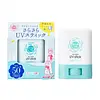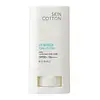What's inside
What's inside
 Key Ingredients
Key Ingredients

 Benefits
Benefits

 Concerns
Concerns

 Ingredients Side-by-side
Ingredients Side-by-side

Polymethylsilsesquioxane
Isononyl Isononanoate
EmollientTriethylhexanoin
MaskingDimethicone
EmollientSynthetic Wax
AbrasiveEthylhexyl Methoxycinnamate
UV AbsorberTrimethylpentanediol/Adipic Acid/Glycerin Crosspolymer
Skin ConditioningButyl Methoxydibenzoylmethane
UV AbsorberDimethicone/Vinyl Dimethicone Crosspolymer
Skin ConditioningAlpha-Arbutin
AntioxidantVitis Vinifera Fruit Extract
Skin ConditioningSalvia Officinalis Extract
AntimicrobialSodium Acetylated Hyaluronate
HumectantScutellaria Baicalensis Root Extract
AstringentMorus Alba Extract
AstringentAnthemis Nobilis Flower Extract
MaskingMalpighia Emarginata Fruit Extract
Skin ConditioningHydrolyzed Collagen
EmollientAloe Barbadensis Leaf Extract
EmollientGlycerin
HumectantWater
Skin ConditioningButylene Glycol
HumectantTocopherol
AntioxidantAlumina
AbrasiveSucrose Polystearate
EmollientPolysilicone-15
UV FilterPhenoxyethanol
PreservativePolymethylsilsesquioxane, Isononyl Isononanoate, Triethylhexanoin, Dimethicone, Synthetic Wax, Ethylhexyl Methoxycinnamate, Trimethylpentanediol/Adipic Acid/Glycerin Crosspolymer, Butyl Methoxydibenzoylmethane, Dimethicone/Vinyl Dimethicone Crosspolymer, Alpha-Arbutin, Vitis Vinifera Fruit Extract, Salvia Officinalis Extract, Sodium Acetylated Hyaluronate, Scutellaria Baicalensis Root Extract, Morus Alba Extract, Anthemis Nobilis Flower Extract, Malpighia Emarginata Fruit Extract, Hydrolyzed Collagen, Aloe Barbadensis Leaf Extract, Glycerin, Water, Butylene Glycol, Tocopherol, Alumina, Sucrose Polystearate, Polysilicone-15, Phenoxyethanol
Polymethylsilsesquioxane
Isononyl Isononanoate
EmollientTriethylhexanoin
MaskingDimethicone
EmollientSynthetic Wax
AbrasiveEthylhexyl Methoxycinnamate
UV AbsorberTrimethylpentanediol/Adipic Acid/Glycerin Crosspolymer
Skin ConditioningButyl Methoxydibenzoylmethane
UV AbsorberDimethicone/Vinyl Dimethicone Crosspolymer
Skin ConditioningNiacinamide
SmoothingEctoin
Skin ConditioningAlteromonas Ferment Extract
Skin ConditioningHydrolyzed Hyaluronic Acid
HumectantC12-13 Alkyl Glyceryl Hydrolyzed Hyaluronate
Sodium Acetylated Hyaluronate
HumectantSodium Hyaluronate
HumectantHydroxypropyltrimonium Hyaluronate
Ceramide NP
Skin ConditioningCeramide AP
Skin ConditioningCeramide EOP
Skin ConditioningSaccharomyces Ferment Filtrate
HumectantCalendula Officinalis Flower Extract
MaskingPolyquaternium-61
Skin ConditioningPhytosphingosine
Skin ConditioningSucrose Polystearate
EmollientPolysilicone-15
UV FilterAlumina
AbrasiveTocopherol
AntioxidantSimethicone
EmollientButylene Glycol
HumectantGlycerin
HumectantSodium Lauroyl Lactylate
EmulsifyingPhenoxyethanol
PreservativeCholesterol
EmollientXanthan Gum
EmulsifyingCarbomer
Emulsion StabilisingWater
Skin ConditioningPolymethylsilsesquioxane, Isononyl Isononanoate, Triethylhexanoin, Dimethicone, Synthetic Wax, Ethylhexyl Methoxycinnamate, Trimethylpentanediol/Adipic Acid/Glycerin Crosspolymer, Butyl Methoxydibenzoylmethane, Dimethicone/Vinyl Dimethicone Crosspolymer, Niacinamide, Ectoin, Alteromonas Ferment Extract, Hydrolyzed Hyaluronic Acid, C12-13 Alkyl Glyceryl Hydrolyzed Hyaluronate, Sodium Acetylated Hyaluronate, Sodium Hyaluronate, Hydroxypropyltrimonium Hyaluronate, Ceramide NP, Ceramide AP, Ceramide EOP, Saccharomyces Ferment Filtrate, Calendula Officinalis Flower Extract, Polyquaternium-61, Phytosphingosine, Sucrose Polystearate, Polysilicone-15, Alumina, Tocopherol, Simethicone, Butylene Glycol, Glycerin, Sodium Lauroyl Lactylate, Phenoxyethanol, Cholesterol, Xanthan Gum, Carbomer, Water
Ingredients Explained
These ingredients are found in both products.
Ingredients higher up in an ingredient list are typically present in a larger amount.
Alumina is another name for the compound aluminum oxide. It is used as a thickener, absorbent, and abrasive.
As an absorbent, alumina can give a mattifying effect. It is used in mineral sunscreens to help coat nano-sized filters, such as titanium dioxide. By increasing the size of the UV filters, these ingredients stay on the skin for a longer time. By coating small sized ingredients, alumina helps thicken a product.
Alumina may be used as an abrasive, or exfoliant.
Alumina is naturally occurring in the mineral corundum. Certain varieties of corundum create rubies and sapphires. Corundum is also the crystalline form of alumina.
Learn more about AluminaAlso known as Avobenzone, this ingredient is a chemical sunscreen filter that provides protection in the UV-A range.
Avobenzone is globally approved and is the most commonly used UV-A filter in the world.
Studies have found that avobenzone becomes ineffective when exposed to UV light (it is not photostable; meaning that it breaks down in sunlight). Because of this, formulations that include avobenzone will usually contain stabilizers such as octocrylene.
However, some modern formulations (looking at you, EU!) are able to stabilize avobenzone by coating the molecules.
Avobenzone does not protect against the UV-B range, so it's important to check that the sunscreen you're using contains other UV filters that do!
The highest concentration of avobenzone permitted is 3% in the US, and 5% in the EU.
Learn more about Butyl MethoxydibenzoylmethaneButylene Glycol (or BG) is used within cosmetic products for a few different reasons:
Overall, Butylene Glycol is a safe and well-rounded ingredient that works well with other ingredients.
Though this ingredient works well with most skin types, some people with sensitive skin may experience a reaction such as allergic rashes, closed comedones, or itchiness.
Learn more about Butylene GlycolDimethicone is a type of synthetic silicone created from natural materials such as quartz.
What it does:
Dimethicone comes in different viscosities:
Depending on the viscosity, dimethicone has different properties.
Ingredients lists don't always show which type is used, so we recommend reaching out to the brand if you have questions about the viscosity.
This ingredient is unlikely to cause irritation because it does not get absorbed into skin. However, people with silicone allergies should be careful about using this ingredient.
Note: Dimethicone may contribute to pilling. This is because it is not oil or water soluble, so pilling may occur when layered with products. When mixed with heavy oils in a formula, the outcome is also quite greasy.
Learn more about DimethiconeThis ingredient is a silicone used to improve the texture of products and absorb oil. It does not get absorbed into the skin.
Like other silicones, Dimethicone/Vinyl Dimethicone Crosspolymer helps condition the skin by creating a barrier. In this sense, it can act as an emollient and trap moisture in.
This ingredient is a type of elastomer.
Learn more about Dimethicone/Vinyl Dimethicone CrosspolymerEthylhexyl Methoxycinnamate is an organic compound that provides UVB protection. It often goes by the more common name of octinoxate. It is created from methoxycinnamic acid and 2-ethylhexanol.
Ethylhexyl Methoxycinnamate absorbs UVB rays with wavelengths between 280-320 nm. UV absorbers protect your skin by using chemical reactions to convert UV rays into heat and energy.
UVB (290-320 nm) rays emit more energy than UVA rays. They are capable of damaging DNA, causing sunburns and are thought to be linked to skin cancer.
The state of Hawaii has banned sunscreens containing octinoxate due to its potential impact on coral reefs. More research is needed to bridge gaps in this research. The European Union allows higher levels of octinoxate in sunscreens than the US and Australia.
Ethylhexyl Methoxycinnamate is oil soluble. It is not stable and may lose efficacy when exposed to sunlight.
Learn more about Ethylhexyl MethoxycinnamateGlycerin is already naturally found in your skin. It helps moisturize and protect your skin.
A study from 2016 found glycerin to be more effective as a humectant than AHAs and hyaluronic acid.
As a humectant, it helps the skin stay hydrated by pulling moisture to your skin. The low molecular weight of glycerin allows it to pull moisture into the deeper layers of your skin.
Hydrated skin improves your skin barrier; Your skin barrier helps protect against irritants and bacteria.
Glycerin has also been found to have antimicrobial and antiviral properties. Due to these properties, glycerin is often used in wound and burn treatments.
In cosmetics, glycerin is usually derived from plants such as soybean or palm. However, it can also be sourced from animals, such as tallow or animal fat.
This ingredient is organic, colorless, odorless, and non-toxic.
Glycerin is the name for this ingredient in American English. British English uses Glycerol/Glycerine.
Learn more about GlycerinIsononyl Isononanoate is a synthetic skin-conditioner and texture enhancer. It is created from nonanoic acid, a fatty acid found in cocoa and lavender oil.
As an emollient, Isononyl Isononanoate helps keep your skin soft and smooth. This is because emollients create a barrier on the skin to trap moisture in.
Isononyl Isononanoate helps give products a velvet feel and improves spreadability.
Learn more about Isononyl IsononanoatePhenoxyethanol is a preservative that has germicide, antimicrobial, and aromatic properties. Studies show that phenoxyethanol can prevent microbial growth. By itself, it has a scent that is similar to that of a rose.
It's often used in formulations along with Caprylyl Glycol to preserve the shelf life of products.
Polymethylsilsesquioxane is a silicone used as a film forming agent.
When applied to the skin, this ingredient creates an invisible film on the surface. This film still allows oxygen to pass through, but prevents moisture from escaping. This can help condition and hydrate the skin. It also leaves a silky feel when applied.
Polymethylsilsesquioxane has not been shown to clog pores. It has been deemed safe to use up to 55%, but most cosmetics use much less.
If you have concerns about using this ingredient, we recommend speaking with a professional.
Learn more about PolymethylsilsesquioxanePolysilicone-15 is a chemical UV filter that absorbs UV-B rays.
It is a photostable ingredient used to boost SPF factor and protect products from UV-induced deterioration.
This ingredient is not water-soluble.
Learn more about Polysilicone-15Sodium Acetylated Hyaluronate is a type of Hyaluronic Acid.
Hyaluronic Acids help moisturize, soothe, and protect the skin.
Read about common types of Hyaluronic Acid here:
Sodium Hyaluronate
Hydrolyzed Hyaluronic Acid
Hyaluronic Acid
We don't have a description for Sucrose Polystearate yet.
Synthetic Wax is created from fossil fuels such as natural gas. It is used to enhance texture, adjust pH, and as an occlusive.
It may also be used as an abrasive ingredient to exfoliate the skin.
Synthetic Wax may not be fungal acne safe.
Learn more about Synthetic WaxTocopherol (also known as Vitamin E) is a common antioxidant used to help protect the skin from free-radicals and strengthen the skin barrier. It's also fat soluble - this means our skin is great at absorbing it.
Vitamin E also helps keep your natural skin lipids healthy. Your lipid skin barrier naturally consists of lipids, ceramides, and fatty acids. Vitamin E offers extra protection for your skin’s lipid barrier, keeping your skin healthy and nourished.
Another benefit is a bit of UV protection. Vitamin E helps reduce the damage caused by UVB rays. (It should not replace your sunscreen). Combining it with Vitamin C can decrease sunburned cells and hyperpigmentation after UV exposure.
You might have noticed Vitamin E + C often paired together. This is because it is great at stabilizing Vitamin C. Using the two together helps increase the effectiveness of both ingredients.
There are often claims that Vitamin E can reduce/prevent scarring, but these claims haven't been confirmed by scientific research.
Learn more about TocopherolTriethylhexanoin is created from glycerin and 2-ethylhexanoic acid. It is a solvent and emollient.
As a solvent, Triethylhexanoin helps dissolve ingredients to stable bases or help evenly distribute ingredients throughout the product.
It is also an emollient and helps condition the skin.
Learn more about TriethylhexanoinWe don't have a description for Trimethylpentanediol/Adipic Acid/Glycerin Crosspolymer yet.
Water. It's the most common cosmetic ingredient of all. You'll usually see it at the top of ingredient lists, meaning that it makes up the largest part of the product.
So why is it so popular? Water most often acts as a solvent - this means that it helps dissolve other ingredients into the formulation.
You'll also recognize water as that liquid we all need to stay alive. If you see this, drink a glass of water. Stay hydrated!
Learn more about Water